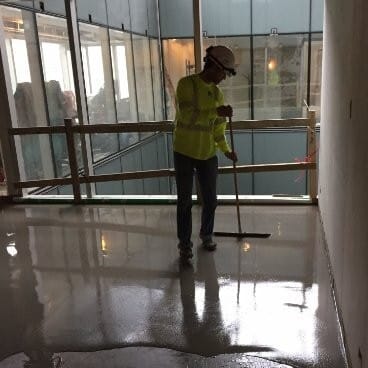
There’s a lot to know about concrete preparation, maintenance and repair! We’ve already covered some of the most common problems you might encounter with concrete in previous blog posts. There’s an article on The Spruce that’s pretty friendly to newcomers to the world of concrete that goes over the pros and cons of using concrete in your business. Concrete, like any material, will invariably wear down over a long enough period of time; generally speaking, defects in concrete flooring occur when water reaches the rebar and rust begins to form, increasing the size of the rebar and breaking up the concrete. When this or other problems occur, get in touch with your specialized industrial flooring contractor. There are many ways they might tackle the repair.
One method that’s used pretty frequently involves a lot of elbow grease: hand applied repairs. These repair systems involve packing mortar into the space that needs repair by hand, and a lot goes into the preparation. First, the substrate needs to be pre-dampened so that the mortar will adhere properly, then a primer has to be applied to the concrete and steel. When this method is used for repairs, it’s usually good news for the business owner; it means the damages are surface level enough that they can be repaired by hand.
After concrete repair has been completed, a fairing coat will often be applied. These coats serve to create an even, protective surface on the concrete after the repair has been done in order to create a more cohesive look. Your contractor will have to remove minor imperfections after the repair work is done to create a smooth surface on which the fairing coat can be applied; cracks will also need to be filled. Special attention will need to be paid to humidity, especially if the repairs are being done in an environment that’s exposed to the elements; if rain is in the forecast, fairing coats can’t be applied outside.
There are a number of protective coatings that may be applied over the concrete after it has been repaired. These coatings are especially useful if a particular danger to the integrity of your concrete had not been identified until it caused damage. There are coatings that are anti-caustic, water-resistant, no-slip and more; depending on your industry, any number of different coatings might be applied over the whole floor once the repair work is done.
There are a plethora of other options for concrete repair, depending on the extent of the damage done. There are flowing options, in which concrete is poured where repair work is needed. There’s also sprayed concrete for very large scale repair; it’s known as shotcrete, and it’s projected at a high velocity in a wet or dry mix. The system of repair that will be chosen will depend on the extent of the damage, and your requirements for speed; the latter can be particularly important if you need to close down for repairs.

